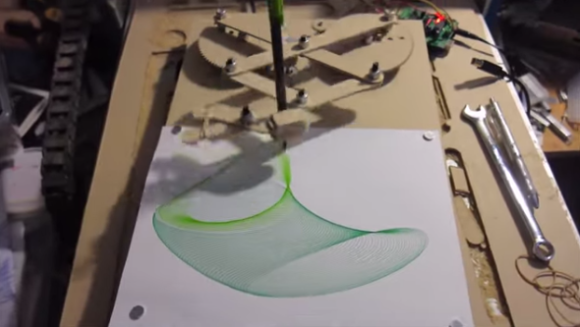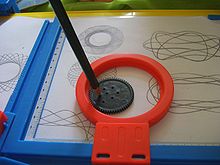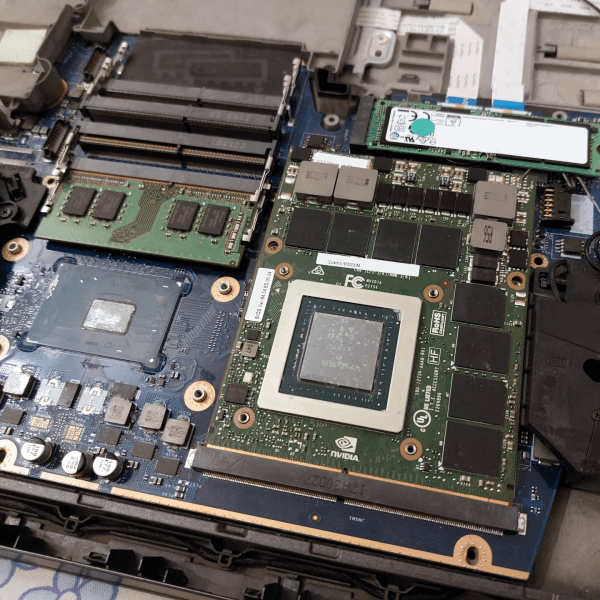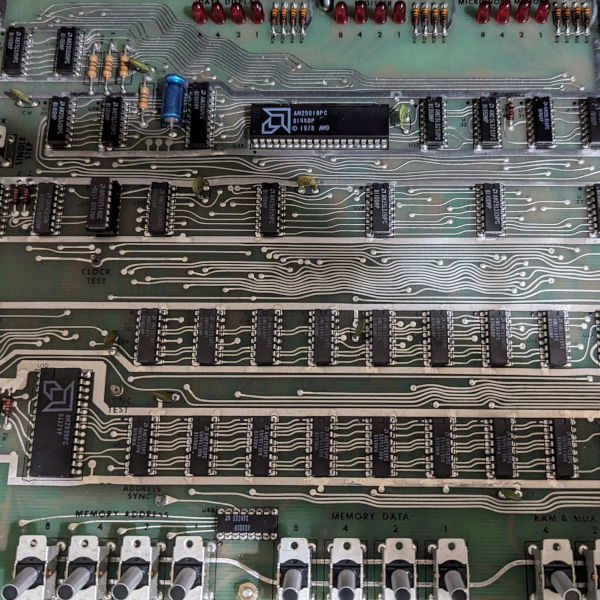
Some of our more senior experienced readers may remember a toy called the Spirograph. In case you don’t, it’s a geometric shape drawing toy. The way it works is a plastic disc with gear teeth around the perimeter and various holes on its face is spun around a plastic ring with gear teeth on the inside. A pencil is inserted in one of the holes in the disc and, when spun around the inside of the ring, draws different complex shapes called hypotrochoids.

This was fun enough to keep a kid entertained for a few minutes. It took a while to make a complete shape and sometimes it was easy to mess up (especially if the hole chosen for the pencil was near the outside of the disc). [Darcy] thought it would be neat to combine the Spirograph’s drawing style with modern technology. The result is called the Art-O-Matic and it draws some pretty wild art, you guessed it, automatically.
Click past the break for more!
[Darcy] started the project by drawing all the gears and linkages in Sketchup. A CNC Router was used to cut out the parts, after that just a few bolts and nuts got the mechanics together. In the video below there are 2 geared discs that move the linkage arms. Both arms move independently, one quickly and the other slowly. Each disc is controlled by its own stepper motor. The speed of each stepper motor is controlled by an Arduino. Different patterns are drawn depending on the speeds of the two motors. Switching pen colors along the way adds to the coolness.

















I’m glad you put the picture of the Spirograph for reference, or we would have had a bad time.
No wonder kids got bored after a few minutes with that thing. Here’s a picture of a real Spirograph: http://tinyurl.com/lmmumq3
“No wonder kids got bored after a few minutes with that thing. Here’s a picture of a real Spirograph: http://tinyurl.com/lmmumq3”
Yes! This is the one I had when I was a kid. First sold by Kenner in 1966, but the idea date as far as 1881. http://en.wikipedia.org/wiki/Spirograph
It wasn’t nearly as boring as you think. They were cool as heck back in the day and kids like me spent hours using them. Pretty much everyone I knew back then had a set.
And FWIW, the spirograph can do a lot of really neat stuff if you take the time and have some patience to learn how to use it properly. It can be very relaxing to just focus on the neat shape, carefull motor control, and making it come out cleanly. I have easily ended up spending a few hours or more using it, without even really trying!
I thought I had already seen this before! You guys linked it in this article http://hackaday.com/2014/05/21/isoscel-ease-drawing-robot-is-mesmerizing/ not that long ago, totally had deja-vu but at least I wasn’t wrong :)
That one is more of a printer (x and y input) than a spirograph (single input).
“You guys linked it in this article…” — if you follow the ‘scissor linkage’ link in the article he referenced, you’ll find it goes to the same site as this article’s ‘Art-O-Matic’ link.
Holy cow! I want to make this!
Made a really simple one with Legos:
https://vine.co/v/Mdib1EzDhMx
http://www.instructables.com/id/Building-a-Drawbot-with-LEGO/
If it matters, a lot of the fine-detail pattern engraving on the intaglio master plates for banknotes etc. is done with a similar widget.
can this thing draw the wankel engine chamber?
Played with spirograph for hours! The biggest problem was the pins would get bent over and you couldn’t push them in, then pull them out.
Wow. Perhaps a successful attempt to wear out the bic?
I have some very similar memories from my own childhood. :)
Also good for testing pens!
Yeah, I could do reviews for pens.
I had the Spirograph as a kid too. I was a fun toy.
I also made a rendition of that: http://inventorartist.com/hey-kids-squiggly-draw/
I keep it in my briefcase and whip it out when I’m at the pub or whatever…
Am I the only one who sees it for the very first time? o_o Seems fun. I have to make 3D printable one ^^
I think it’s a great candidate for 3d printing. I was thinking of coming up with something better than bolts so it can be configurable without using a wrench…
Is it just me or does anyone else think it makes a cool sound as well as cool pictures?
I’m going to describe a similar drawing machine a friend of mine in grade school made (with some assistance from his dad), back in 1984 or so, that mesmerised all of us, both in it’s simplicity, and in the beauty of the drawings it made…
Imagine a table, made of wood, 4 feet on a side, and standing approximately 4 feet tall. The table was made of 2 x 4’s and plywood – nothing special.
On two adjacent edges, each centered between the legs, was hung a pendulum made of steel, with a rigid arm and an adjustable weight (which could be slid up and down the arm). Each pendulum fit thru a slot on the table, and pivoted on “knife edge” supports.
There was a third pendulum as well, positioned on the diagonal that bisected the table of the triangles formed by the adjacent edges. It was positioned toward the corner, and pivoted on a knife edge as well. If I remember right, the “leg” on that corner was composed of two “legs” positioned away from the corner, to allow for the pendulum to swing freely between them.
Now – attached to the upper end of the first two pendulums was a couple of thin brass wire rods (or maybe it was straightened coathangers?) which were pivoted in such a manner as to move a “pen holder” (which was made of some brazed/soldered/welded steel or brass nut or something) in the X and Y cartesian plane. You’d put a pen in the holder (wrapped with tape or something so that it would have a snug fit).
Now – by themselves, those two pendulums would only move the pen in a complex pattern (that I now know as a “lissajous” pattern – but I didn’t know that then) – interesting in its own right, but that isn’t what gave the magic to the system.
It was that third pendulum that did that. See, it too had a rod which extended from it, but not to the pen holder. Instead, it attached to a “carriage” that moved along the diagonal in a straight line. The carriage, which was made from a piece of wood, was mounted on a couple of HO-gauge hobby train cars, which rode on a couple of pieces of straight track. This carriage was positioned below the pen holder, such that when the pendulums were all at rest, the pen holder was located in the center of the wood. On the top of this wood would be pinned or taped the piece of paper for the drawing.
Operation was simple: Put a pen in the holder, start each of the pendulums (which by consequence of their weight position and starting points would have different periods and lengths of oscillation), then let the pen down gently onto the paper. Because of the weight of each pendulum, and the overall low friction of the system – the machine would work its “magic” – it would sometimes take 15 minutes for all the pendulums to still themselves and the drawing to be finished. It was also possible to lift the pen off the drawing and swap it out for another color…
No two drawings were ever the same – they could never be made the same, actually, and that was a part of its charm and beauty. While the Art-O-Matic presented here could easily make similar drawings, it could easily make duplicates. Some might call that a feature – I am not so sure on that, myself…
I think you’re referring to a harmonograph. There is a link to one in the related in the art-o-matic post…
senior readers? shoot, man, I’m 20 and when I was a kid spirographs were my JAM